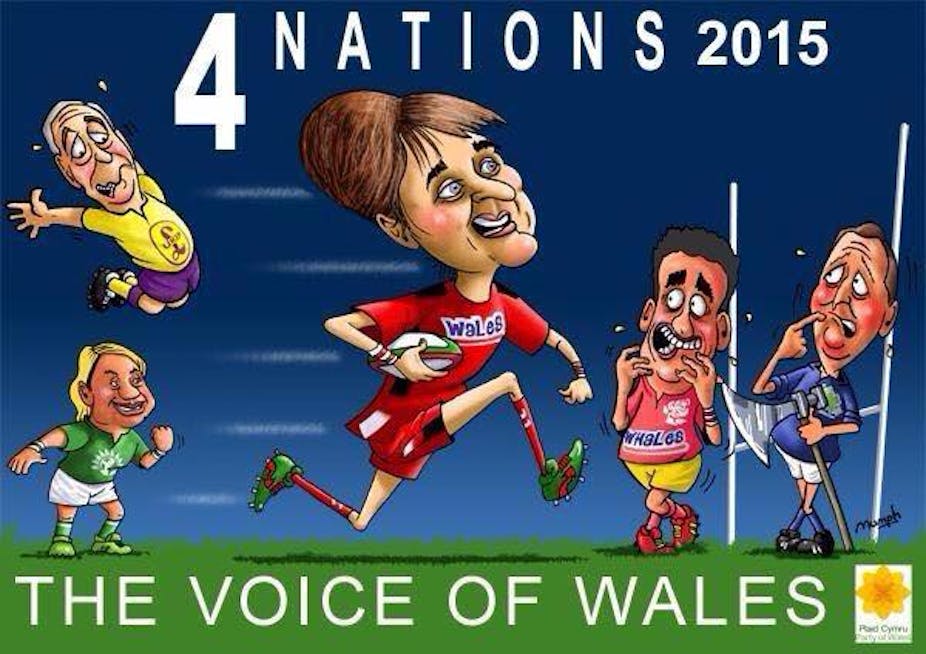Imagine the post-apocalyptic scenario, where the Welsh rugby team is thrashed 56-3 by Scotland. Amidst the doomsday spectre of an empty Millennium Stadium would be calls for the coach to be sacked, the team dismantled and the tactics radically overhauled.
Now, substitute this vision for the recent performance of Plaid Cymru in the 2015 general election. Merely holding on to its three MPs in the Welsh language heartlands looks paltry in comparison to the bounty of 56 seats, enjoyed by the SNP. And Plaid’s 12.1% of the Welsh vote was dwarfed by the SNP’s 50% of the Scottish vote share. Consequently, while the SNP are by some distance the largest party in Scotland, Plaid remain in fourth place in Wales behind Labour, the Conservatives and UKIP, apparently unable to exploit numerous opportunities presented to it, namely:
The positive momentum generated by the SNP’s popularity in the wake of the Independence referendum.
-
The capitulation of the Liberal Democrats.
The lethargy of Labour’s campaign and the Miliband “Marmite” factor.
The unprecedented exposure enjoyed by Leanne Wood in the leaders’ debates.
Unlike some of her counterparts, Leanne Wood has not found herself on the leaders’ scrapheap. In fact, examinations of Plaid’s performance have praised her conduct. One Plaid AM has gone as far as to suggest that she now has “huge” potential to be seen as an alternative First Minister of Wales. The successful Borgen-isation of Wood’s image, the conviction of her Voice of Wales campaign and the alliance with the SNP’s Nicola Sturgeon suggest a revitalised Plaid Cymru brand. Various polls suggested Wood was the most-liked Welsh politician and also the one that “best stands up for the people of Wales”.

And yet, it is clear that Wood’s popularity did not translate into a deluge of votes. In fact, her prominence – combined with the buoyancy of “cybernats” on social media – may well have provided an over-inflated estimation of Plaid’s chances. The reality is that holding on to its three existing seats, and coming within 229 votes of capturing one of its target seats in Ynys Môn, was far from disastrous.
Is it a fair fight?
Traditionally, neither the SNP nor Plaid have performed spectacularly well in Westminster elections, but as professor Laura McAllister has suggested, the parties are not “two sides of the same coin”. Although both now share similar aspirations towards independence and progressive left-of-centre policies, the respective identities of Scotland and Wales have, historically, been very different. The fact that Plaid hasn’t been swept upwards by the SNP whirlwind isn’t really so surprising after all.
To begin with, Scotland’s union with England was achieved on a more equal footing than the 16th century Acts of Union that “incorporated” Wales. And Scotland retained many significant aspects of statehood, such as Scots Law and a separate education system. This enabled it to pull far ahead of Wales in terms of administrative devolution: Wales got its first Secretary of State in 1964; the Scottish equivalent had been established in the 19th century.
This provided the Scots with a broader sense of civic identity, which, combined with the 1970s narrative of “Scotland’s oil”, saw the Welsh playing a game of constitutional catch-up. Unsurprisingly, in both the 1979 and 1997 referenda, devolution proved far more appealing to Scottish voters than it did to those in Wales.
A language game
From its incipient years in the 1930s, the SNP was driven more by constitutional reform than a desire to reinforce Scottish cultural distinctiveness. By contrast, the purpose of Plaid Cymru stems from a fear of language decline that often alienated it from the majority non-Welsh speaking population, and led to unsubstantiated allegations that it was “fascist”.
In her memoirs, the SNP’s Winnie Ewing recalls telling Plaid Cymru’s leader Gwynfor Evans that she was envious of the “linguistic heritage” of Wales. She was rather surprised by his response that, unlike Wales, support for the SNP could come from anywhere as “an inbuilt patriotic response which was not dependent on language.”
What’s more, British and English-centric values have retained a firmer grip on Wales. The recent election witnessed drastic contrasts in the UKIP poll, with the party gaining 13.6% of the vote in Wales, but only scraping 1.6% in Scotland. And while both Labour and the Conservatives have seemingly failed to adjust to devolution north of the border – allowing the SNP to mop up the populist protest vote – both parties have successfully promoted and cultivated their “Welsh” credentials.
The question now is, where next for Plaid? While the success of UKIP suggests – at least in part – Plaid’s failure to attract Labour’s disillusioned working-class vote, there are also fears among some of its supporters that it has abandoned the centre-ground to the resurgent Conservatives. As the Welsh Assembly has acquired further powers, support for Welsh independence has also dwindled: 6% according to the latest St David’s Day Poll, but as low as 3% in the aftermath of the Scottish independence referendum.
With Leanne Wood – a socialist from the Rhondda – at its helm, the 2016 assembly elections will be the ultimate barometer of Plaid’s ability to transcend its historical image as a factional language pressure group. If Plaid fails to make a strong showing, it will be testament to its failure to emulate the SNP’s broad-church appeal. But, it will also highlight that Welsh dragons and Scottish lions are very far from being the same species.

